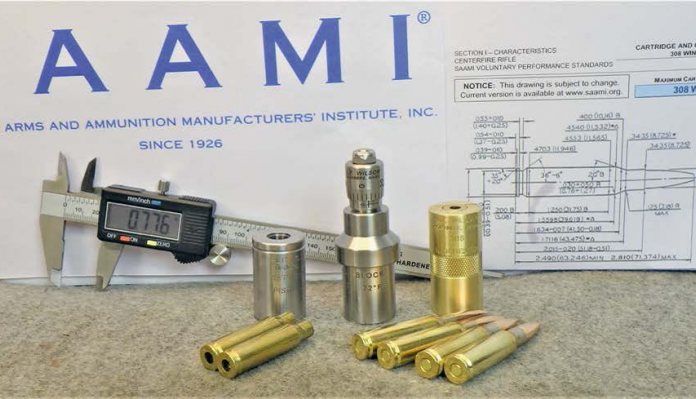Reloading Basics - SAAMI Regulations
-
0
 Comments
Comments
- Last updated: 14/06/2022

Just about every manufactured product in the modern world is made to a set of standards, and ammunition is no exception. The Sporting Arms and Ammunition Manufacturers’ Institute (SAAMI) was established in 1926 and although it is based in America its standards are adopted across most of the world. Their purpose; to set industry standards for interchangeability, reliability, and quality in regard to ammunition and firearms.
Basically, it ensures that if you buy a .308 Winchester rifle, and any brand of ammo, the two can be used safely and effectively together. It seems obvious that this should be the case, but regulation by the Institute ensures that you do not have to concern yourself with the compatibility of guns and ammunition of the same calibre. So how does this influence the reloader?
For a rifle cartridge to perform properly, and accurately, it must fit perfectly in the gun’s magazine and chamber, both of which will usually have been made to SAAMI standards (to do this it must actually be very slightly smaller than the chamber). For any given bottlenecked cartridge there are over 20, different dimensions to consider, and some of these must have tolerances. These then have to match those of the chamber, which has tolerances itself, and no two chambers are identical.
If you make your own ammunition you will have come to realise how critical this is, you have probably made some rounds that would not fit. Of course, you do have the advantage of having your rifle to hand, so you can check the fit with a dummy round as you are developing your load. However, commercial ammunition manufacturers, have to be sure their products will fit ANY gun of the appropriate calibre. Because all their ammunition is loaded to SAAMI specification it will fit in any rifle that is built by any manufacturer.
Reloading dies are made to match the specifications set by SAAMI too, ensuring that the ammunition you produce will work in any rifle built to their standards. You can of course adjust some of the settings, to make ammunition that does not match these dimensions, such as the cartridge overall length (COL), in order to tune it to your own particular gun. Neck-only resizing dies do not return the case walls to SAAMI standard dimensions, they are left to the ‘fire-formed’ size that fits your own gun’s dimension. If you are only going to use your reloaded cases in that same rifle this non-compliance with SAAMI standards does not matter. But, if you are reloading them for more than one gun, then full length resizing is necessary.
As far as reloading is concerned, SAAMI standards are something you initially need to follow closely, to ensure your ammunition is safe and functions properly in your rifle. Their COL and other critical dimensions will get you on the right track and help to fit any gun in your chosen calibre. Later on, it will be possible to tweak the length of your rounds and use cases fire-formed in your gun without full length resizing them back to standard dimensions.
So how do you check your rounds are compliant with the specifications? If you go to the SAAMI website you can find a detailed drawing of the ammunition and the chamber for every common calibre available, and even some ‘wildcats. Using that information, you can carry out some simple checks on your finished rounds by measuring all the external dimensions with an accurate caliper.
There are also specialised tools and gauges, that are produced specifically to make checking your ammunition a lot easier and more precise. These are made to very tight tolerances and allow you to slip cases, or completed rounds, into cavities within them which mimic the dimensions of a compliant chamber of the given calibre. Although a bit expensive, they make it possible to very quickly establish that your cases are the correct length and your ammunition will chamber in any SAAMI-chambered gun.
The L. E Wilson Minimum Dimension Gauge, as the name suggests, has an internal cavity manufactured to the proscribed minimum chamber dimensions for any given calibre. This means that if your ammunition slides in smoothly and easily then it will fit a SAAMI compliant chamber. If you find that your ammunition fits the gauge easily, but then does not fit the chamber of your gun, you have a very tight chamber which is tighter than the specifications. If the tip of the bullet sticks out of the end of the gauge then you need to take a closer look at the COL of your finished ammunition.
Their Brass Case Gauge allows you to check the overall length to see if they need trimming. It also allows you to check how much you are pushing the shoulder back during resizing, which is useful as you should keep the amount of resizing to a minimum to reduce the amount of stress the brass undergoes. A Case Gauge Depth micrometer can be purchased separately to make measuring the amount of shoulder setback easier and very accurate. Experimenting with the amount of shoulder push back can allow you to improve the performance of your ammunition.
The SAAMI standards are provided to give both commercial ammunition makers and the hand loaders, safe and interchangeable dimensions for their rounds. They are an ideal starting point and a constant reminder of the correct ‘standard’ dimensions for reloaded ammunition. You can of course deviate from some of their dimensions, to make ammunition that performs best in your particular gun, but they are without doubt, the perfect reference point.
